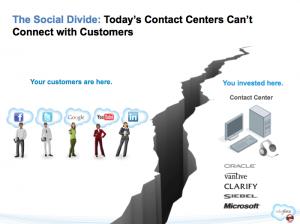Last week I was talking with one of our customers about a new project. The customer was already a big Salesforce Sales Cloud user, and now they were adopting Service Cloud. The project focused on migrating a portion of their service infrastructure from an old email response system to Salesforce…and potentially still using email as the primary channel for customer engagement.
Sure, people still use email to communicate with companies for service-related issues, but the once commonly used “email response system” is changing. Many of our customers, in servicing and supporting customers of their own, have seen a steady decline in email volume combined with an increase in other channels – Facebook, communities, chat, YouTube, etc. Salesforce.com illustrates this trend best in the diagram below:
Just when you thought your call center investment was paid off, your customers changed the game. They are engaging with your company not through an application or email system but through other channels—new “pools,” if you will. Innovative companies have followed their customers and are reaching and responding quickly where they are active. We call it “swimming in their pool.”
In the context of the Social Enterprise, Service Cloud is about more than just deploying a solution to your customers. It’s increasingly about “swimming in their pool” and doing business their way and not vice versa. The key driving question is: How can you go where they are to make it easier and more convenient to provide service and support to them?
How can you swim in their pool?
1. Use a platform that enables interaction across many channels.
- Given the growing number of pools your customers swim in – Facebook, Twitter, YouTube, communities, and more – choose a platform that has the greatest number of pre-built integrations to these pools. Also, look for a pool that provides strong integration capabilities if a pre-built connection is not native. This allows you to focus on process, not building technology.
2. Train your service agents to swim.
- The way service agents engage with customers in their multiple pools is very different from the old back-and-forth cadence of email response systems or even phone support. It’s critical that you roll out to your agents training that includes issue routing, responding with content appropriate to the pool from which the interaction originates, and timeliness of response calibrated to your customers’ expectations.
3. Take a phased approach
- Don’t be overwhelmed by the number of channels, or feel compelled to support them all immediately. Prioritize. Determine where your audience swims the most and pick the top one or two first. Revise and refine. Get those channels right, and then move on to additional pools armed with that experience.
In upcoming blogs I will be highlighting examples of how Perficient customers are swimming in their customers’ pools.
Need swimming lessons? Contact Perficient!

